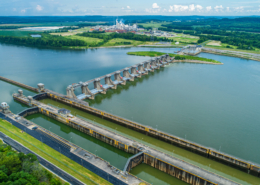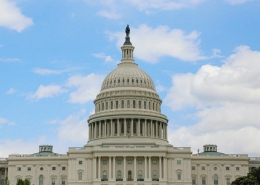The Senate Environment and Public Works’ subcommittee on Clean Air, Climate, and Nuclear held a hearing on Wednesday, July 26, to discuss opportunities to reduce emissions from the rail network in the United States. Three witnesses testified at the hearing.
- Ivette Torres, Community Research Lead, People’s Collective for Environmental Justice | Written Testimony
- Carl Rosen, General President, United Electrical, Radio, and Machine Workers of America | Written Testimony
- Ian Jefferies, President & CEO, American Association of Railroads | Written Testimony
Subcommittee chair Edward Markey (D-MA) began by talking about the significance of the rail network to the country. He said that railroads were once a crown jewel of America, but they have lost the taste for American innovation. Their EPA emissions have not been updated since 2008, and nearly half of the Class I locomotive fleet is over 20 years old. He said these fleets emit seven times more nitrous oxide and thirteen times more particulate matter (soot) as new cleaner locomotives, impacting rail workers and communities that reside near rail lines. He, however, expressed optimism that railroads can supercharge the future with the technology and workforce that is already existing.
The ranking minority member, Pete Ricketts (R-NE), said that railroads are critically important for the economy. He said rail is extremely fuel efficient, moving 28 percent of total freight ton-miles while resulting in only 1.7 percent of total transportation related GHG emissions in the country. He said that using renewable fuels for railroads can create a win-win scenario as they can create value for farmers across the country and support jobs while reducing emissions.
Sen. Ricketts also highlighted issues with electrification of rail. Specifically, he spoke about how deploying a unique locomotive technology would create captive fleets that can serve only small geographic regions on an otherwise highly national rail system that relies on interoperability. He said this could impact profitability of railroads and, therefore, disrupt supply chains.
Carl Rosen said that their organization unequivocally favors stricter emission standards for rail. He said that railroads have been very slow to integrate existing emission standards as only 10 percent of Class I fleet is Tier 4 (latest EPA standard for locomotives) with over 75 percent of it being Tier 2 or lower. This defies earlier EPA estimations that 30 percent of the fleet will be Tier 4 by 2023. He said that adoption of Tier 4 and battery-operated locomotives is not a matter of technological feasibility, but of priorities, as such locomotives have already been in production and use for a while now.
Ivette Torres expanded on the public health impacts of freight movement on people. “Freight system is poisoning us and our communities,” she said, adding that anyone living close to a rail line, rail yard, or port, is most likely to have a lower life span due to risk of cancer. She also spoke about how idling of locomotives locks in and traps communities, sometime cutting off access to emergency vehicles. She stressed that one-third of world’s rail lines are electric and urged the rail industry to consider switching to overhead catenary. She clarified that people from her community are not against freight movement, as they recognize the benefits from it, but they want a transition to zero emission technologies.
Ian Jefferies said that US railroads spend over $25 billion dollars a year of their money on the rail network. He also stressed on the environmental benefits of rail, saying that, if just 10 percent of freight moved by nation’s highways is moved by rail instead, annual emissions would fall by 20 million tons, which is equivalent to taking 4.1 million cars out of the highways every year. He said the rail industry supports practical policies grounded in data, including restoring the Highway Trust Fund (HTF) to a user-pays system and a national VMT pilot program. He further said that mandates that would force the adoption of technologies would have staggering impacts on small businesses, adding that the rule by California Air Resources Board (CARB) will drive 25 percent of short lines in the state out of business. He also noted that the adoption of catenary on a 140,000-mile rail network is unrealistic.
There were four issues that were discussed during the hearing.
Tier 4 locomotives: The adoption of Tier 4 locomotives, in compliance with the latest EPA standard, was discussed. Rosen spoke about the benefits of switching to Tier 4 locomotives. He said they reduced particulate matter by 70 percent and nitrous oxide emissions by 76 percent while also meeting higher crashworthiness standards. In response to Sen. Ricketts’ question about the cost of Tier 4 locomotives, Jefferies said that it would cost about $4 million per locomotive with upwards of a 40-year lifetime. Torres explained a loophole in the current law, which allows railroads to retain their existing old fleet if they used refurbished locomotives, which would not have to comply with the current emission standard. Sen. Cynthia Lummis (R-WY) questioned Rosen whether the CARB rule in California, which would mean turnover of about three-fourths of the locomotive fleet, would shift freight away from rail. Rosen said that they have production capacity to meet the fleet turnover needs, but the railroads have not been placing orders.
Zero-emission locomotives: Rosen said that railroads have the money and resources to invest in zero-emission technologies, and it’s all about their priorities. He emphasized that switchover to low- and zero-emission fleets is a great investment in the long term as it leads to fuel savings. Jefferies mentioned that there is an undersupply of battery electric locomotives as battery availability is a challenge. He also said that the railroads are investing over a billion dollars already in new locomotive technologies and that they have placed a few orders of after initial tests showed promise. He, however, clarified that there is no capability right now for widescale fleet replacement involving thousands of locomotives and it would take multiple decades for that to happen. Sen. Markey asked Torres if rail will still be more efficient than trucks in California even after the recent agreement between California state and truck manufacturers. Torres said that, as of this year, it would be cleaner and healthier to transport by trucks. She said that rail is falling behind because of its negligence to invest in zero emission technologies.
Catenary: Jefferies explained the challenges of building overhead catenary over a 140,000-mile rail network operating 24 hours a day in different weather conditions spanning different topographies. He further said that it would require building of power stations and new power sources, which are not readily available in rural areas, and reworking tunnels, bridges, and locomotives. While he seemed optimistic about achieving that in urban areas, he said that rural areas are a challenge, adding that it would take millions of dollars per mile and decades to do it across the network. Rosen said that battery-electric locomotives can be used in certain stretches where overhead catenary is not possible (example: tunnels). He stressed that, as we are anyway transforming the entire power system in the country, electrification of rail is something that must be done. Sen. Markey said that the cost of converting half the fleet to catenary is $100 billion (AAR statistic). He contrasted that with $183 billion that was earned in the last 10 years in stock buybacks and dividends. “That is money that is not spent on safety, not spent on workers,” he said.
Sustainable fuels: There was bipartisan support for sustainable fuels. There was agreement from both sides for a national low carbon fuel standard, which would increase the availability and reduce the cost of low carbon fuels. Sen. Ricketts said that renewable fuels is an area of common agreement, adding that the failure of the EPA to establish renewable volume obligations (RVOs) at a level that the is already being produced by the industry discourages more investment. Jefferies emphasized on the need for a mode-neutral approach and said that Congress must create a level-playing field for sustainable fuel development to ensure that all modes can increase deployment.













